


Many Heads Are Always Better Than One
Time, attention, and craft are among the most beautiful, lasting experiences one professional can share with another. The author, a student investigator at MITRE, reflects …

Leadership and Super Heroes: Creating Amazing Innovative Cultures—Part 1
Although I’m a mere mortal myself, I do admire leaders with the gift of inspiring—not ordering—others to collaborate and do meaningful work. Command and control approaches are easy to set up, but they don’t necessarily enable enduring greatness or creativity. The...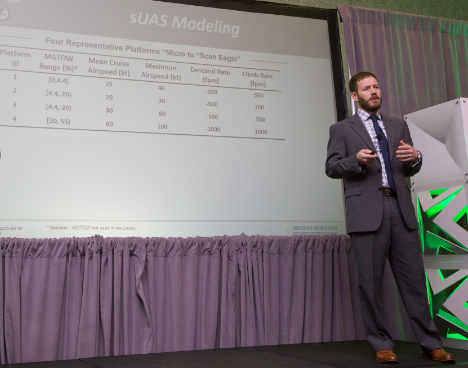
At Xponential 2017, MITRE Staff Share Information on Unmanned Aircraft Systems
As co-chair of the Unmanned Aircraft Systems Science and Research Panel, MITRE’s Ted Lester recently presented an update on the past two years of the panel’s work, at the Association for Unmanned Vehicle Systems International’s (AUVSI) Xponential 2017...
From Surface to Space in Just Two Conferences
MITRE works with the Federal Aviation Administration to enable the safest, most efficient aerospace system in the world and to meet the evolving needs of the nation’s airspace. We have supported the FAA’s mission for more than 50 years and have operated...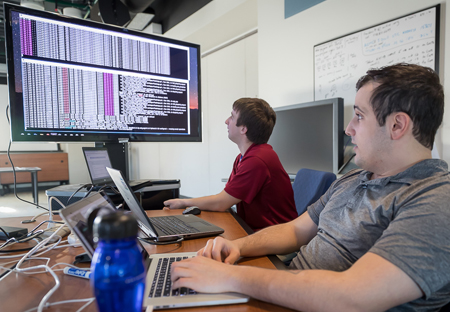
MITRE Hackathon Examines the Impact of Emerging Mobile Technologies
The 42 staffers and interns who participated in MITRE’s 2017 Hackathon aimed to connect around problems not projects. and connect they did, using Discuss@MITRE, Github, Hackathon.io, Slack, our internal wiki (MITREpedia)–and these are just the tools. The...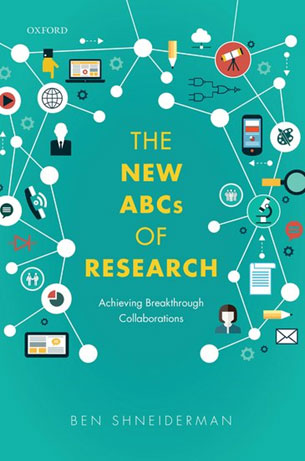
The New ABCs of Research: Part 2
At his MITRE Innovation Speaker Series talk this past May, Ben Shneiderman talked about his newest book, The New ABCs of Research: Achieving Breakthrough Collaborations, a guide for junior researchers and a manifesto for senior researchers, academic administrators,...
Don’t present—Collaborate! —in Workspaces Designed to Inspire the Contemporary Knowledge Workforce
Even the perpetually frustrated cartoon character Dilbert might take heart if he were to find himself in a workspace that actually supported creativity in a flexible, casual environment designed for human beings. The fantasy is becoming reality as office design...
What does it mean to share: MITRE developers talk about the value of documentation
When you hear the word documentation, if the first image that pops into your head is the crummy user guide you just threw away, you are in for a surprise. In the hands of Alex Lyte, John Griffith, Tod Levitt, and Leo Obrst, documentation is an indispensable business...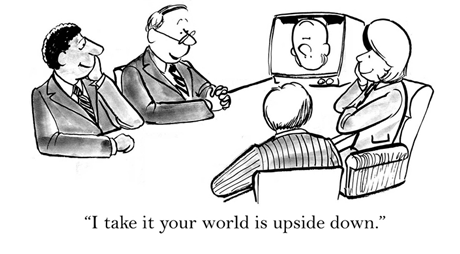
The Daily Standup
In Liz Hayes’s post about routine check-ins, seemingly simple collaboration processes and trust enable hard-working, distributed teams to succeed. —Editor Author: Liz HayesI joined a new project last summer, a Global Information System (GIS) effort run by Keith W....
Avoiding Single Points of Failure Through Knowledge Sharing
Knowledge management is all about making sure that all components of an organization, project, or task can work together regardless of staff rotation. We capture, store, share, analyze, and share some more precisely because who’s coming or going will change. Sadia...
From Telewho to Teleyou: Engaging as a Teleworker at MITRE
Brett Profitt’s observation that “MITRE sets teleworkers up for success, but teleworkers must endeavor to be successful” resonated. No matter how many business process tools an organization makes available, staff have to use them to good end. And he does, mentioning...
Recent MITRE publication, Sociocultural Behavior Sensemaking: State of the Art in Understanding the Operational Environment, Demonstrates Value of Collaborative Knowledge Management Practices
Recent MITRE publication, Sociocultural Behavior Sensemaking: State of the Art in Understanding the Operational Environment, Demonstrates Value of Collaborative Knowledge Management Practices Dr. David Foster, a social behavioral scientist at MITRE, faced a challenge...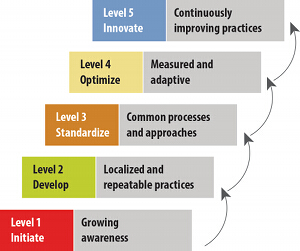
When a Lack of Heroics Best Serves Veterans
A good friend and mentor reminds me regularly that knowledge management is a journey, not a destination. Which makes maturity models the boon companion of the KM discipline. This post eyes the prize through the lens of a new volunteer effort that helps military...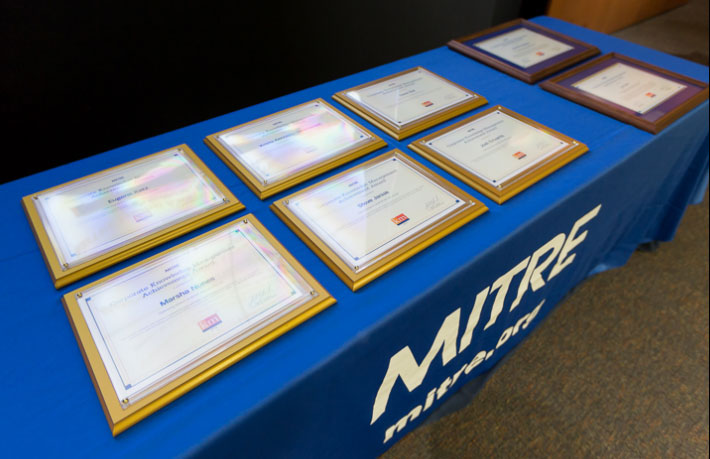
MITRE’s Knowledge Management Award Program
Awards! Who doesn’t like to be recognized for good work? Yet Knowledge Management Awards programs are not ubiquitous. Marcie Zaharee discusses MITRE’s original awards program and its results. In 2016, MITRE will launch a new program, as the company explores the role...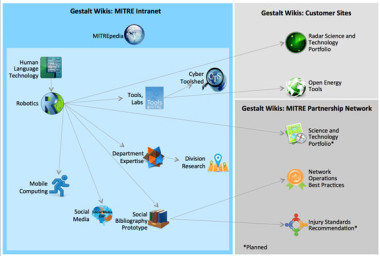
Gestalt Wikis at MITRE: Origins
Gestalt Wikis at MITRE: Origins
This blog post is the first of four in a series about Gestalt Wikis at MITRE. MITRE began using wikis on the corporate intranet in 2005 with the volunteer grassroots creation of MITREpedia. MITREpedia uses open source MediaWiki[1] as its underlying wiki software. The objective as stated in its Main Page was to capture information about MITRE “people, projects, organizations, customers, technology and more.”[2] In a recent conversation with its founder, Harry Sleeper, the motivation behind MITREpedia was elaborated as to provide a collaborative environment where staff could author linked narratives of well-formed, detailed knowledge about their work.
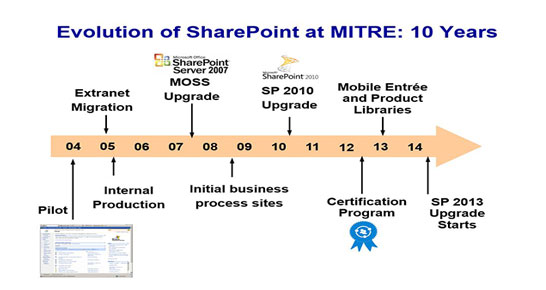
10 Years of SharePoint: Growth and Evolution of a Collaborative Platform
MITRE started using SharePoint with a small pilot in 2003 and now has a robust set of several thousand intranet and extranet sites based on SharePoint 2010. It is used as a content management platform, a collaborative team platform (for projects, organizations and CoPs), for work process capture and scheduling, employee engagement, and blogging. It has become critical to MITRE’s business processes, resulting in an evolution of its capabilities over the years.
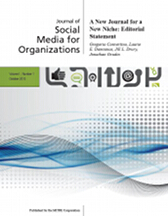
New Online Journal: “Social Media for Organizations”
With the popularity of social media in purely social contexts, I’ve been fascinated by the implications for using these tools for work-related purposes. In recent years, organizations of all types—whether they are industrial, academic, government, or non-profit—are increasingly turning to social media tools such as wikis, blogs, microblogs, and social networking for internal use. By doing so, they hope to enhance collaboration, streamline business processes, and improve relationships.

Enterprise Social, Five Years in
In 2009, “social” was still a buzzword, Facebook was years away from an IPO, and Instagram has not been invented. Yet a groundswell was beginning – people used to the ease of sharing in their online social networks came to their offices, only to find that exchanging information was difficult at best. Communications flowed from the top of the organizational hierarchy down, flooding the already overflowing email inboxes – while cross-organizational collaboration was severely impeded.
